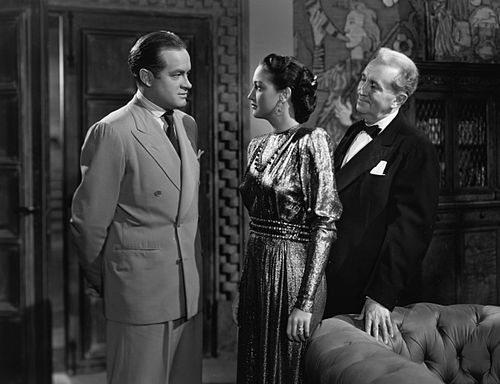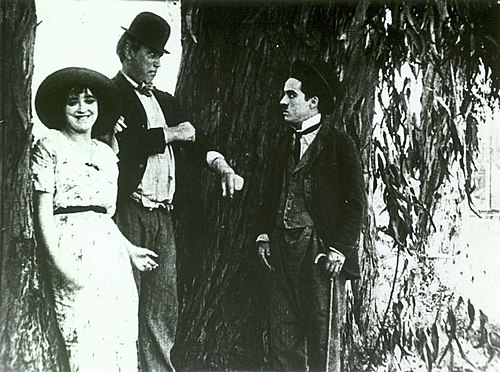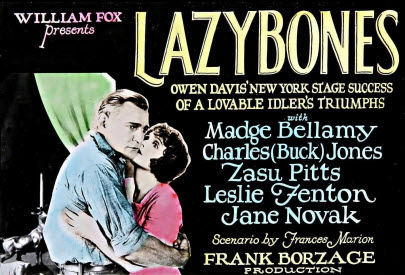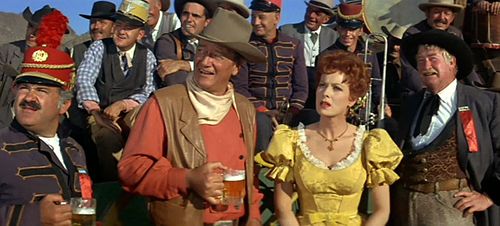Advertisement

Image source: Wikimedia Foundation (wikimedia.org)
Download Movie [Video Format: MP4]
Movie Source: Internet Archive (archive.org)
Advertisement
Advertisement
Rene Clair's - And Then There Were None
1945
Rene Clair weaves the quintessential spider web with brilliant camera work including unusual but effective angles, snappy dialogue, and magnificent performances by ten impeccably cast artists. The viewer is drawn into the anxiety, claustrophobia, terror, and resignation felt one-by-one by each of the twelve weekend "guests" of Mr. Owen. Any mystery, suspense or thriller fan will be incomplete without seeing this work of absolute genius. This may be the best mystery ever put to film
File:And Then There Were None (1945).webm
And Then There Were None is a 1945 film adaptation of Agatha Christie's best-selling mystery fiction<></> And Then There Were None and is directed by René Clair.<></>
The film changes certain characters' names and adheres to the ending of the stage play rather than that of the novel.
The cast featured Barry Fitzgerald, Walter Huston, Louis Hayward, Roland Young, June Duprez, Mischa Auer, C. Aubrey Smith, Judith Anderson, Richard Haydn and Queenie Leonard as the people stranded on the island. The film won the Golden Leopard at the Locarno International Film Festival.< name="Locarno"></>
Though it was produced by a major studio, 20th Century Fox, the copyright was allowed to lapse and the film is now in the public domain. Several different editions of varying quality have been released to home video formats.
Plot
Eight people, all total strangers to each other, are invited to small, isolated Indian Island off the coast of Devon, England, by Mr. and Mrs. Owen. They settle in at a mansion tended by two newly hired servants, Thomas and Ethel Rogers, but their hosts are absent. When the guests sit down to dinner, they notice the centerpiece, ten figurines of Indians in a circle. Afterward, Thomas puts on a gramophone record, from which a voice accuses them all of murder:- General Sir John Mandrake (C. Aubrey Smith), of ordering his wife's lover, a lieutenant, to his death
- Emily Brent (Judith Anderson), of the death of her young nephew
- Dr. Edward G. Armstrong (Walter Huston), of drunkenness which resulted in a patient dying
- Prince Nikita Starloff (Mischa Auer), of killing a couple
- Vera Claythorne (June Duprez), of murdering her sister's fiance
- Judge Francis J. Quinncannon (Barry Fitzgerald), of being responsible for the hanging of an innocent man
- Philip Lombard (Louis Hayward), of killing 21 East African tribesmen
- William H. Blore (Roland Young), of perjury, resulting in an innocent man's death
- Thomas (Richard Haydn) and Ethel Rogers (Queenie Leonard), of the demise of their previous employer, an invalid.
Starloff admits to speeding and running down a couple. Then he takes a drink and dies from poison. The next morning, the guests learn that Mrs. Rogers has died in her sleep. Quinncannon reports that Rogers found one figurine broken after Starloff's demise. Now another is missing. With two deaths matching the Ten Little Indians nursery rhyme, they search the island for "Mr. Owen" without success. After General Mandrake is stabbed in the back, the judge arrives at the only explanation: Owen must be one of them.
Another day passes. Everyone votes secretly for whom they suspect. Only Rogers receives two votes, and is sent to spend the night in the woodshed. After locking the dining room, they give Rogers the key. The next morning, however, they find him dead, his head split open with an axe. Vera Claythorne persuades Miss Brent to reveal that she had her nephew placed in a ormatory, where he hanged himself. Later that day, Miss Brent's body is found with a hypodermic needle nearby. Armstrong discovers his is missing. Lombard admits he had a revolver, but it is lost as well.
At dinner, Quinncannon confesses he sentenced an innocent man to death to ruin the defending counsel's reputation. Armstrong then admits to operating while drunk, with fatal results. Blore grudgingly discloses that he perjured himself to put an innocent man in prison, where he died. Lombard merely states that the accusation against him is true. When it is Claythorne's turn, she excuses herself to get her coat. The others hear her shriek and rush to her. In the confusion, a single gunshot is heard. They find Vera shaken after being brushed by seaweed hanging from the ceiling, which she mistook for a cold hand. They also spot Lombard's gun, and Quinncannon apparently dead from a shot to the head.
Claythorne insists she is innocent, but Armstrong contends that only a person who had not committed a crime would want to mete out "justice" and locks her in her room. Later that night, she wakes to find Lombard outside her window. After he gives her his gun, she lets him inside. He persuades her to admit that it was her sister who killed her own fiancé, and Vera helped her cover up the crime and unofficially took the blame, caring for her sister until she died. They hear someone going downstairs. Upon investigation, they realize that Armstrong is missing.
The next morning, Blore is struck while outside by stonework toppled from the floor above. Lombard takes the binoculars beside the body and sees what Blore had -- a corpse on the beach. It is Armstrong. Claythorne pulls out the gun, certain that Lombard is the killer. Lombard tells her that his real name is Charles Morley, and that he impersonated his friend to discover if the invitation had anything to do with his friend's suicide.
Vera fires, and he drops. She returns to the mansion to find Quinncannon very much alive. The judge tells her that all his life he had searched for perfect justice. After learning that he was terminally ill, he concocted this plan. He persuaded Armstrong to fake his (Quinncannon's) death, supposedly to help catch Owen, then murdered Armstrong. He tells Vera Claythorne that she can either hang herself or be sent to the gallows (as the only possible perpetrator). He drinks poisoned whiskey, but he sees Morley before he dies and realizes that his scheme has been foiled. Vera had missed intentionally. Boat owner Fred Narracott returns to the island, asking the couple if the party is ready to leave, to which they reply, "You get them!", and run off to the boat.
Cast
File:And Then There Were None 1945.jpg- Barry Fitzgerald...Judge Francis J. Quinncannon
- Walter Huston...Dr. Edward G. Armstrong
- Louis Hayward...Philip Lombard/Charles Morley
- June Duprez...Vera Claythorne
- Roland Young...Detective William Henry Blore
- Mischa Auer...Prince Nikita "Nikki" Starloff
- C. Aubrey Smith...General Sir John Mandrake
- Judith Anderson...Emily Brent
- Richard Haydn...Thomas Rogers
- Queenie Leonard...Ethel Rogers
Screenplay
=Differences from the novel=
This adaptation of the novel took, overall, fewer liberties with Christie's plot than some of the other versions. Most of changes were made in order to comply with the strict censorship of the day, which included changing the backstories behind Miss Brent's and Vera Claythorne's crimes, since a film that would imply such themes as child murder and teenage pregnancy would never be allowed to be viewed by the general public.Some of the other characters' names and crimes were also changed. Judge Francis J Quincannon was known as Justice Lawrence J Wargrave in the book. General Sir John Mandrake was called General John Gordon Macarthur and Prince Nikita Starloff replaced Anthony Marston. In the novel, Marston had killed two children--John and Lucy Combes--while driving recklessly.
The ending, though, is radically altered. Only the 1987 Desyat Negrityat version kept the novel's ending. This film, like all the other Western versions, changed the shooting of Philip Lombard (played by Louis Hayward) and the suicide of Vera Claythorne's character (played by June Duprez) in favour of a more upbeat ending. Vera pretends to shoot Lombard so that the real murderer will believe he is dead.
In this, the film follows the altered denouement Christie herself had rewritten for her And Then There Were None (1943 play) of the book. There is one major alteration — in the play, Vera thinks she has shot Lombard, after which the murderer appears and attacks her; Lombard, who was only grazed, comes to at the last minute and shoots the murderer as he is about to strangle the terrified girl. The film, however, simply has Vera help Lombard fake his death, then confront the culprit who commits suicide after revealing his motive and murder techniques.
All in all, the end result is the same; the two major characters are left alive and innocent of the crimes they were accused of. Later remakes in 1965, 1974, and 1989 (all using the title Ten Little Indians), also used one of these two revised finales.
One final alteration is the title. Christie's novel was originally titled Ten Little Niggers and then it was changed to Ten Little Indians, the title it is often known by today. In some countries, such as UK and Australia, the novel was renamed And Then There Were None.
Reception
And Then There Were None currently holds a 100% approval rating on Rotten Tomatoes.Remakes
Christie's mystery has been filmed a number of times, including as Ten Little Indians (1965 film) (1965), And Then There Were None (1974 film) (1974), Desyat Negrityat (1987) and Ten Little Indians (1989 film) (1989), with variations to its characters and locale.
See also
Category:1945 films
Category:1940s mystery films
Category:American mystery films
Category:Black-and-white films
Category:English-language films
Category:Films based on works by Agatha Christie
Category:Films directed by René Clair
Category:Films set in country houses
Category:Films set in Devon
Category:Films set on islands
Category:Golden Leopard winners
René Clair, Leo C. Popkin, Harry M. Popkin






